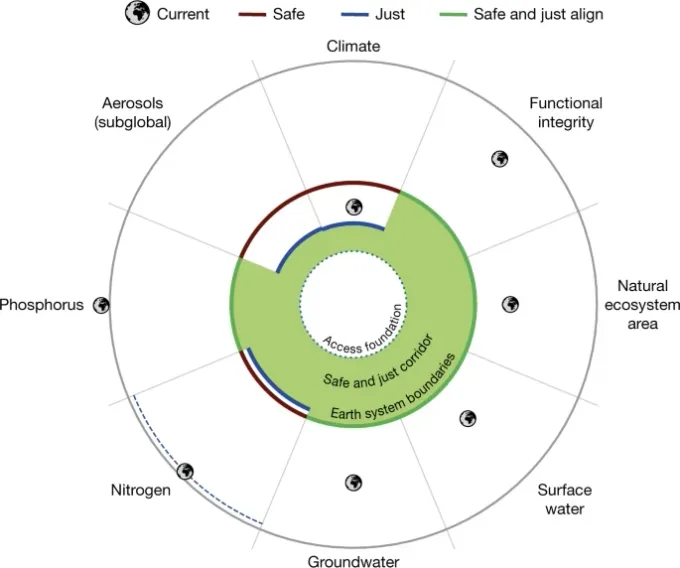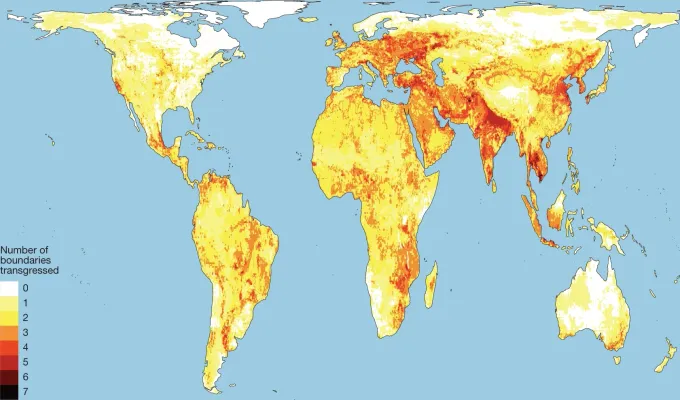If Earth were to get an annual health checkup akin to a person's physical exam, a doctor would say the planet is "really quite sick right now."
That's how Joyeeta Gupta, professor of environment and development at the University of Amsterdam, put it at a Wednesday press conference accompanying the publication of new research in the peer-reviewed journal Nature. Co-authored by Gupta and 50 other scientists from around the world, it warns that nearly every threshold for a "safe and just" planet has already been breached and pleads for swift action to protect "the global commons for all people now and into the future."
As Carbon Brief reported: "The new study develops the idea of 'planetary boundaries,' first set out in an influential 2009 paper. The paper had defined a set of interlinked thresholds that it said would ensure a 'safe operating space for humanity.' Its authors had warned that crossing these thresholds 'could have disastrous consequences.'"
"We cannot have a biophysically safe planet without justice."
The new paper, written by many of the same people, introduces justice considerations into the framework, leading the authors to propose a set of "safe and just" Earth system boundaries (ESBs) at global and sub-global scales, some of which are stricter than the "safe" limits outlined previously.
"For the first time, we present quantifiable numbers and a solid scientific foundation to assess the state of our planetary health not only in terms of Earth system stability and resilience but also in terms of human well-being and equity/justice," said lead author Johan Rockström, director of the Potsdam Institute for Climate Impact Research.
The interdisciplinary team focused on five of the nine planetary systems identified in 2009—climate, biosphere, water, nutrient cycles, and atmosphere. To determine the health of these systems, they relied on the following eight measurable indicators:
- Global mean surface temperature change since the pre-industrial era (climate);
- Natural ecosystem area (biosphere);
- Functional integrity (biosphere);
- Surface water flows (water);
- Groundwater levels (water);
- Nitrogen (nutrient cycles);
- Phosphorous (nutrient cycles); and
- Aerosol loading (atmosphere).
As Phys.orgreported: "Safe boundaries ensure stable and resilient conditions on Earth, and use an interglacial Holocene-like Earth system functioning as a reference point for a healthy planet. A stable and resilient Earth is dominated by balancing feedbacks that cope with buffer and dampen disturbances. Cutting-edge science on climate tipping points features as one major line of evidence to set safe boundaries."
To establish "just" boundaries for each indicator, the authors assessed the conditions needed to avert "significant harm," which they defined as "widespread severe existential or irreversible negative impacts on countries, communities, and individuals from Earth system change, such as loss of lives, livelihoods, or incomes; displacement; loss of food, water, or nutritional security; and chronic disease, injury, or malnutrition."
As summarized by Carbon Brief, the researchers took into account the following justice criteria:
- Interspecies justice: prioritizing other species and ecosystems in addition to humanity.
- Intergenerational justice: considering how actions taken today will impact future generations.
- Intragenerational justice: accounting for factors including race, class, and gender, which "underpin inequality, vulnerability and the capacity to respond" to changes in planetary systems.
"The results of our health check are quite concerning: Within the five analyzed domains, several boundaries, on a global and local scale, are already transgressed," Rockström said. "This means that unless a timely transformation occurs, it is most likely that irreversible tipping points and widespread impacts on human well-being will be unavoidable. Avoiding that scenario is crucial if we want to secure a safe and just future for current and future generations."
According to the paper, "Social and economic systems run on unsustainable resource extraction and consumption" have pushed Earth past seven of the eight "safe and just" ESBs.
The paper includes the following image for reference. The Earth icons representing the current state of the planet should be in the green space, which marks where "safe" (red) and "just" (blue) ESBs overlap. Instead, they lie beyond the "safe and just corridor" for every indicator except aerosol loading.

When "safe" ESBs are looked at in isolation, the planet has entered the danger zone for six of the eight indicators. According to the authors, 1.2°C of global warming to date has pushed the world beyond the "just" ESB for climate, which requires mean surface temperature rise to be capped at 1.0°C. For now, the climate still remains in the "safe" threshold, they say, even as the impacts of increasingly frequent and intense extreme weather are already being felt, especially by the poor.
However, Gupta stressed that "justice is a necessity for humanity to live within planetary limits."
"This is a conclusion seen across the scientific community in multiple heavyweight environmental assessments," said Gupta. "It is not a political choice. Overwhelming evidence shows that a just and equitable approach is essential to planetary stability."
"We cannot have a biophysically safe planet without justice," she added. "This includes setting just targets to prevent significant harm and guarantee access to resources to people and for as well as just transformations to achieve those targets."
As Carbon Brief pointed out: "This study is the first to assess Earth-system boundaries at a local scale, rather than analyzing the planet as a whole. This allows the authors to determine which boundaries have been crossed in specific regions and to identify 'hotspots' for breached boundaries."
As a result, researchers were able to produce the following map, which shows that more boundaries have been breached in certain areas, including Eastern Europe, the Middle East, South and Southeast Asia, and substantial parts of Africa, Brazil, Mexico, China, and the U.S. West.

Rockström told reporters that the eight indicators were "carefully chosen" to be "implementable for stakeholders... across the world."
The researchers hope that the "safe and just" ESBs they have put forth "will underpin the setting of new science-based targets for businesses, cities, and governments to address the polycrises of: increasing human exposure to the climate emergency, biodiversity decline, water shortages, ecosystem damage from fertilizer overuse in some parts of the world coupled with lack of access elsewhere, and health damage from air pollution," Phys.org reported.
"Stewardship of the global commons has never been more urgent or important."
Rockström and Gupta are co-chairs of the Earth Commission, founded in 2019 "to advance the planetary boundaries framework," Carbon Brief observed. "The concept has been widely used in academia and policy spaces, but has also attracted criticism from scientists who say it oversimplifies a complex system, or could spread political will too thinly."
Earth Commission executive director Wendy Broadgate, for her part, said that "a safe and just transformation to a manageable planet requires urgent, collective action by multiple actors, especially in government and business to act within Earth system boundaries to keep our life support system of the planet intact."
"Stewardship of the global commons has never been more urgent or important," she added.
In their conclusion, the authors wrote that "nothing less than a just global transformation across all ESBs is required to ensure human well-being."
"Such transformations must be systemic across energy, food, urban, and other sectors, addressing the economic, technological, political, and other drivers of Earth system change, and ensure access for the poor through reductions and reallocation of resource use," they added. "All evidence suggests this will not be a linear journey; it requires a leap in our understanding of how justice, economics, technology, and global cooperation can be furthered in the service of a safe and just future."

